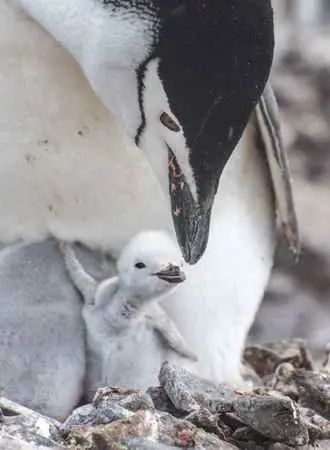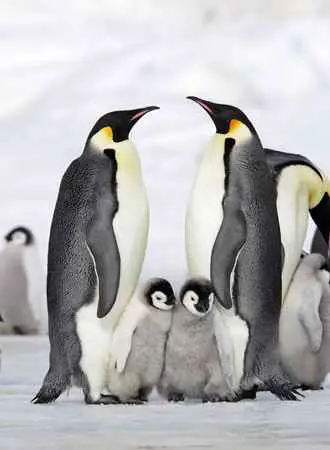Penguins are very interesting animals. They have a lot of different characteristics, including their appearance, their behavior, and the way they live. One question that many people ask is whether or not penguins can have penguin twins.
Of the 18 species of penguin, 16 can lay two eggs which means these penguins can have twins. The two sub-Antarctic and Antarctic penguins that can’t have twins are the King and Emperor penguins. These penguins only ever lay just one egg.
- 16 out of the 18 species of penguins can have twins. King and Emperor penguins are the only two species that lay only one egg.
- All penguins lay eggs and both male and female penguins share the responsibility of incubating the eggs.
- Chinstrap and Yellow-Eyed penguins are the only species that take care of both of their newborn baby penguins simultaneously. In captivity, there have been documented cases of penguin twins.
Do All Penguins Lay Eggs?
Yes, laying eggs instead of giving birth is a common setup among bird species. There are currently 18 species of penguins and all of them lay eggs. Here is the list of penguins:
Emperor Penguin
King Penguins
Gentoo Penguins
Adelie Penguins
Chinstrap Penguins
Southern Rockhopper Penguins
Northern Rockhopper Penguins
Macaroni Penguins
Fiordland Crested Penguins
Royal penguins
Snares crested penguins
Erect-crested penguins
Little Blue Penguin or Fairy Penguin
Yellow-Eyed Penguins
Magellanic Penguin
Humboldt Penguin
Galapagos Penguins
African Penguins
The male penguin starts the mating ritual with the female penguin and finds good nesting sites. The male fasts and lives off his body fat during the courtship, nesting, and incubation periods. He can lose up to 45% of his body weight during this time.

After mating, the female penguin lays one egg. All other species of penguins can lay two eggs. The two parents will take turns holding the eggs between their legs to keep them warm in a nest.
How Can Penguins Have Twins?
Every breeding season, penguins come back together to the breeding sites. They find a partner and mate within days. The result of this mating is a clutch of eggs. These eggs can be laid in a nest, on the bare ground, or onto the feet of the parents.
Although the penguin eggs are laid a few days apart like all birds, they are still counted as one birth. If two eggs are laid together, there is a possibility that they will hatch into twin penguins. However, this doesn’t mean that the penguins will be able to raise two chicks to maturity. Usually, one of the eggs is not as good as the other and is used as a backup in case something happens to the favored egg such as being taken by land predators.
Chinstrap and Yellow-Eyed penguins are the only species of penguins that care for both of their newly-born baby penguins at the same time. They hatch around the same time and both newborn penguins are fed and treated equally.
In captivity, there have been documented events where the parent penguins have twins. At Genoa Aquarium, the staff was celebrating the recent arrivals of four baby Magellanic penguins. Two of the four baby penguins of Genoa Aquarium are twins. In late November 2011, a female penguin at the Toronto zoo gave birth to two babies.
Where Do Penguins Lay Their Eggs?
Breeding occurs on land or ice for all penguin species. Breeding times will be based on the optimum time for finding food for their newly-born baby penguins in the ocean. Every other penguin lays two eggs, except the Emperor, and King penguins lay one egg at best.
The Emperor and King Penguins keep their eggs warm by nesting them on their feet and keeping them in a brood pouch on their bellies. This protects the eggs from the harsh elements of the Antarctic and sub-Antarctic environments in which they live.
Emperor penguins are the largest species of penguins. The weight ranges from 22.7 to 45.4 kg (50 to 100 lb). On average, 95.1% of adult emperor penguins survive each year, and they have an average life expectancy of 19.9 years. As the temperature rises because of climate change, the sea ice in Antarctica is melting. This is making it harder for penguins to find a place to live.
These birds breed on the pack ice and waters of Antarctica under bad weather conditions. There are no materials to build nests in Antarctica, but the eggs must be kept warm until they hatch. So the female, who leaves the colony over winter, gives the egg to her partner who carefully puts it on his feet and covers it with his brood patch. The body heat keeps the eggs warm.
Penguins can also use natural burrows such as caves, cracks, and holes. Some penguins, like the Fiordland Penguin, will nest in the rainforest vegetation. Male Little Penguins create their burrows by themselves.

Why Do Some Penguins Reject Their Baby Penguins?
In some penguin species, the clutch of eggs laid doesn’t always hatch. Of the two eggs laid, the first egg is not real. It’s just a dummy egg. The second egg that is laid is the keeper egg. This second egg is a little bit bigger and it hatches at the same time as the first egg. But even though it hatches at the same time, the first egg is often kicked out of the nest before it can hatch. This is a common occurrence in Rockhopper and Macaroni penguins.
Some penguin species, like the Magellanic, Galapagos, and Humboldt penguins can lay two or three eggs. The first egg is always larger than the second egg. The first egg hatches first and that baby penguin gets to eat all the food for 2 days before the other one is even born. This way it always has an advantage over any food the parent penguins bring back to the nest. The second baby penguin only gets to eat anything when the first one is full.
Penguin twins are popular in captivity because they are interesting to look at and people want to see them. In zoos and other aquariums, it is easy to find food for two baby penguins and there is no danger from predators. However, in the wild or natural habitat, it is not easy to find enough food sources for two baby penguins, and often the second penguin does not survive.
How Often Do Emperor Penguins Lay Eggs?
Emperor penguins are flightless birds that have long captivated the imaginations of people all over the world. These iconic birds are known for their distinctive appearance and their remarkable ability to survive in some of the most extreme environments on Earth. One question that often comes up about emperor penguins is how often they lay eggs.
In general, emperor penguins start to court each other in March or April and the female lays a single egg in May or June. The male incubates the egg in his brood pouch for about 65 days.
After the chick hatches, both parents will take turns caring for it until it is ready to fend for itself. Given the challenges of raising a young emperor penguin, it is not surprising that these birds only reproduce once a year.

What Do Baby Emperor Penguin Chicks Look Like?
Emperor chicks are born covered in gray, white, or brown feathers and a white belly. As they grow older, they will start to change and have black and white feathers like most other penguins. They will start to shed their fluff in about a month and reach adult plumage when they are about one year old.
How Long Do Baby Penguins Stay With Their Parents?
The time that baby penguins stay with their parents varies depending on the species. For Adelie penguins, it ranges from seven to nine weeks, while for king penguin chicks it is 13 months.
Most penguin species need their parents for food during this period. Eventually, the chicks develop waterproof feathers and are able to enter the water on their own which happens in about a month. However, they still rely on their parents for food until they are fully grown. It may take them three to eight years to reach sexual maturity and begin breeding.

Why Do Penguins Abandon Chicks?
Unlike ducks and swans, who take their young to the water and help them learn how to forage, penguin parents abandon their chicks when they are about five months old. The fledglings become very hungry and eventually leave the colony to find open water on their own. When they do, they have to learn quickly what and how to hunt.
While this may seem like a cold-hearted way of raising offspring, it is actually beneficial for the penguins. If the parents stayed with their chicks, they would only be able to find enough food for themselves, and the chicks would likely starve.
By leaving the colony, the fledglings have a better chance of finding food and surviving. In addition, abandoning their young allows penguin parents to breed again more quickly. Abandoning their young is actually an adaptive strategy that helps penguins to survive in their harsh environment.
How Do Penguins Recognize Their Chicks?
Adult penguins can recognize their own chick by its call. They will feed their chick only. If they hear a chick with a different call, they will ignore it. This ensures that each parent is only feeding its own offspring.
Penguins also have a good sense of smell, which they use to identify their chicks. Chicks have a unique scent, which their parents can recognize. This helps to prevent adults from accidentally feeding another penguin’s chick.
In addition, penguins can also identify their chicks by their appearance. Each chick has a unique plumage pattern, which its parents can use to distinguish it from other chicks. By using a combination of calls, smells, and appearance, penguins are able to successfully identify their own chicks.

Do Male Penguins Incubate Eggs?
One of the most interesting aspects of emperor penguin biology is the role that males play in incubating eggs. While females hunt for food in the ocean, males remain on land to incubate the eggs.
During winter storms, the penguins huddle together to keep warm, and the male penguins rotate to the center of the huddle to protect the eggs from the cold. This behavior ensures that the eggs are properly incubated and that the chicks have a good chance of survival.
Adult male emperor penguins are able to produce a nutrient-rich fluid called crop milk. This milk is created in their digestive tract and is fed to their young. The milk is pale yellow and has the consistency of cottage cheese.
When the female returns to her mate, the egg is ready to hatch.
The Bottom Line on Can Penguins Have Twin Penguins
So, can adult penguins have twin penguins? Yes. Most penguins that lay two eggs can potentially have twin penguins except for the Emperor and King penguins that only ever lay a single egg. All other penguin species have the potential to have twins, but it’s extremely rare.






